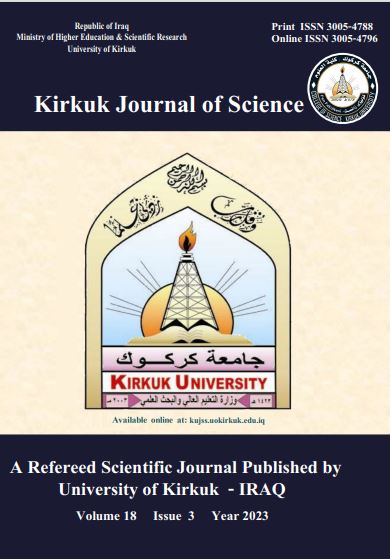Abstract
In an effort to highlight the role of digestion and maceration methods to determine the
strength of antibacterial effect and phytochemical elements of coriander seeds aqueous and
methanolic extracts. Five concentrations (20, 40, 80, 160 and 320 mg/ml) of four extracts
(aqueous by maceration, aqueous by digestion, methanolic by maceration and methanolic by
digestion) were utilized against five clinically isolated bacteria (Staphylococcus aureus,
Escherichia coli, Klebsiella pneumoniae, Pseudomonas aerogenosa and Acenitobacter
baumani), and compared with ciprofloxacin and cefotaxime discs as control. Agar well diffusion
technique was employed to clarify the antibacterial activity of the extracts' concentrations
relaying on quantifying the diameter of inhibition zone (IZ) in millimeter. The bioactive
chemical compounds of four extracts were specified by means of conventional systems. In the
main, all extracts inhibited the growth of every bacterial species starting from (80) mg/ml
concentration, forming IZs' with various measurements that their expansion was drawing upon
the rising of extracts' concentrations. The IZs that proceeded from (160, 320) mg/ml
concentrations were larger than that come out from cefotaxime. The maceration extracts declared
their embracement of alkaloids, and their impact were vigorous compared with the extracts of
digestion which marked by comprising the tannins and flavonoids in aqueous and methanolic
extracts one by one. The most susceptible bacterium to ethanolic extracts was S. aureus. It could
be benefiting from coriander seeds for treatment of bacterial infections through extraction the best active phytoconstituents by using both of suitable extraction technique and solvents
together.
strength of antibacterial effect and phytochemical elements of coriander seeds aqueous and
methanolic extracts. Five concentrations (20, 40, 80, 160 and 320 mg/ml) of four extracts
(aqueous by maceration, aqueous by digestion, methanolic by maceration and methanolic by
digestion) were utilized against five clinically isolated bacteria (Staphylococcus aureus,
Escherichia coli, Klebsiella pneumoniae, Pseudomonas aerogenosa and Acenitobacter
baumani), and compared with ciprofloxacin and cefotaxime discs as control. Agar well diffusion
technique was employed to clarify the antibacterial activity of the extracts' concentrations
relaying on quantifying the diameter of inhibition zone (IZ) in millimeter. The bioactive
chemical compounds of four extracts were specified by means of conventional systems. In the
main, all extracts inhibited the growth of every bacterial species starting from (80) mg/ml
concentration, forming IZs' with various measurements that their expansion was drawing upon
the rising of extracts' concentrations. The IZs that proceeded from (160, 320) mg/ml
concentrations were larger than that come out from cefotaxime. The maceration extracts declared
their embracement of alkaloids, and their impact were vigorous compared with the extracts of
digestion which marked by comprising the tannins and flavonoids in aqueous and methanolic
extracts one by one. The most susceptible bacterium to ethanolic extracts was S. aureus. It could
be benefiting from coriander seeds for treatment of bacterial infections through extraction the best active phytoconstituents by using both of suitable extraction technique and solvents
together.
Keywords
Antibacterial
Coriander seeds
Phytohemical.
Abstract
بهدف القاء الضوء على دور طريقتي التنقيع و الهضم نحو تحديد قوة مفعول مضاد الجراثيم و العناصر الكيميائية النباتية للمستخلص المائي و الميثانولي لبذور الكزبرة. استخدمت خمسة تراكيز mg/ ml (20, 40, 80, 160, 320) للمستخلصات الاربعة (المائي بالتنقيع، المائي بالهضم، الميثانولي بالتنقيع، الميثانولي بالهضم) تجاه خمسة جراثيم معزولة سريريا (Staphylococcus aureus, Escherichia coli, Klebsiella pneumoniae,Pseudomonas aerogenosa و Acenitobacter baumanii) و تمت المقارنة مع اقراص ciprofloxacin و cefotaxime كسيطرة. استعملت تقنية انتشار حفر الاغرة (الهلام) لتوضيح الفاعلية المضادة للجراثيم لتراكيز المستخلصات من خلال قياس احزمة التثبيط بالملمتر. وقد عينت المركبات الكيميائية الفعالة حيويا للمستخلصات الاربعة من خلال الطرق المألوفة. على العموم، جميع المستخلصات ثبطت نمو كل انواع الجراثيم ابتداء من تركيز mg/ml )80(، مشكلة احزمة تثبيط ذات قياسات مختلفة و التي كانت اتساعها مستندة الى ارتفاع تراكيز المستخلصات. ان احزمة التثبيط اللتي نشات من التركيزين mg/ ml (160, 320) كانت اكبر من تلك التي برزت من cefotaxime. اظهرت مستخلصات التنقيع تضمنها القلويدات، و كانت تأثيرهن قوية مقارنة مع مستخلصات الهضم التي تميزت باشتمالها على التنينات و الفلافينودات في مستخلصي المائي و الميثانولي على التوالي. اكثر الجراثيم حساسية لمستخلصات الميثانول كانت S. aureus. من الممكن الانتفاع من بذور الكزبرة في علاج الاصابات الجرثومية من خلال استخلاص المكونات الكيميائية النباتية الافضل تأثيرا باستخدام كلا من تقنية الاستخلاص و المذيبات المناسبتين معا.
Keywords
بذور الكزبرة، مضاد الجراثيم، كيميائية نباتية.
